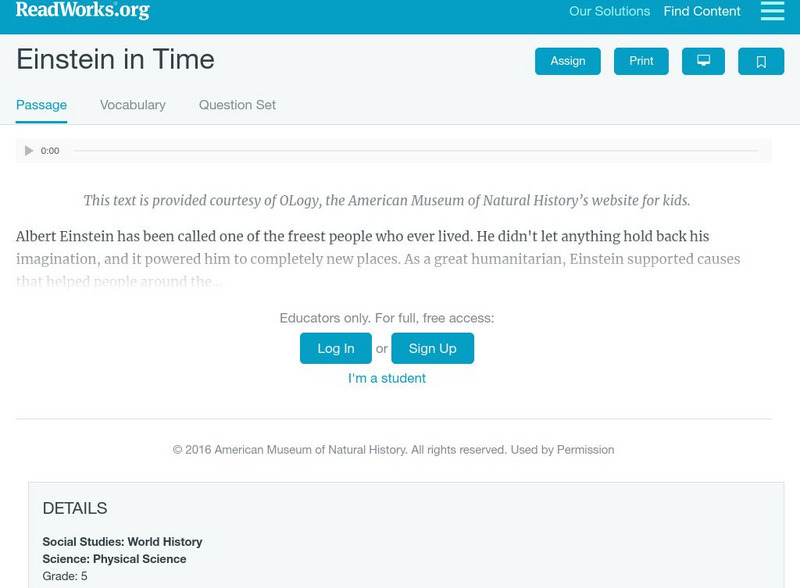Curated OER
Astrology: Fact or Fiction?
Young scholars explore the topic of astrology and review the beliefs behind it. They read sample horoscopes. Using a portable digital planetarium, they view the night sky and the zodiac constellations. They examine and discuss the...
Curated OER
How Do We Know...?
Students identify and explain how various inventions and astronomers have improved our appreciation of the universe. Students identify at least two constellations in the sky and discuss how they were used in ancient times to tell time...
Curated OER
How much rice to US farmers grow?
Fourth graders examine rice farming. In this rice farming lesson, 4th graders compute how much of the world's rice the US produces. Students gain information about the history of growing rice and how much rice other countries grow as...
Curated OER
Light Bounce
Students solve problems involving triangles. In this geometry lesson, students apply properties of triangles to find the missing angles and sides. They identify angles of parallel lines cut by a transversal.
Curated OER
Investigation 4 - Collision Zone
Third graders study how forces of push and pull can change speed or direction.
Curated OER
Investigation 3 - Weighty MistakesStudents
Third graders investigate levers and the concept of work.
Curated OER
Do It Yourself: Energy Transfer Lesson Plan
Fifth graders discuss the different types of energy and experiment with tesla coil to show the three types of energy transfer. They write conclusions in their science journal.
Curated OER
Imagery on Fabric
Students practice placing images on their completed quilts. Using their quilt they made in an earlier lesson plan, they print off photographs from a printer and use heat to transfer them to the fabric. They share their quilts with the...
Curated OER
Quantum Physics
Students discuss the mass-energy relationship based on Einstein's work. They calculate the energy released in various scenerios and sketch diagrams for the Lyman, Balmer and Pfund Series. In groups, they discuss the role of photons and...
Curated OER
Timelinging The Start of America
Students engage in a instructional activity that covers the history of America from its beginnings. They create a timeline of the events covered in chronological order. The instructional activity also includes a timeline quiz that is...
Curated OER
Researching and Writing in the Jungle
Students practice research and writing skills. They pick an animal to resarch from the template chioces and write a paragraph about the animal. In addition, a digital camera is used to insert student pictures onto the slides.
Curated OER
Jeopardy Game
Students review terms and concepts related to the class through games. They play a jeopardy style game to review concepts realted to the class.
Curated OER
Stellar Navigation Curriculum
Students investigate the concept of star mapping and how it is used in space navigation. They conduct various activities to see the effect of mapping. Also the teacher uses models and demonstrations in order to communicate the main...
Curated OER
Star Quest
Students engage in a lesson of using maps in order to find constellations in the night sky. They also conduct research using three constellations. The research is used to create a project to inform others. The teacher also leads the...
Curated OER
Stellar Lunar Curriculum
Students engage in a lesson about the moon and three different constellations. They conduct research using a variety of resources. The teacher leads the class with demonstrations and discussion groups. The research is also guided using...
Curated OER
Sky Stories Curriculum
Students investigate the stories told by ancient cultures about the constellations. They listen to stories told by the Greeks and Romans. The classroom should have posters of constellations for the lesson and the teacher performs...
Curated OER
Hubble Space Telescope
High schoolers investigate the universe through the eyes of the Hubble space telescope. They conduct research from looking at the universe that is simulated with a digital projector. The images are projected onto the wall in a simulation...
Kansas State
The Laser Adventure
Kansas State University site explaining all aspects of LASERS. The site is set up as an online book with clickable chapters.
Science Buddies
Science Buddies: Using a Laser to Measure the Speed of Light in Jello
Think it takes expensive, sophisticated equipment to measure the speed of light? Think again. Outfit yourself with a simple handheld laser pointer, a protractor, and Jell-O, and you're ready to get started.
Science4Fun
Science4 Fun: Lasers
What is a laser? Illustrated discussion of lasers includes how they work and how they are used.
National High Magnetic Field Laboratory
Magnet Academy: Theodore Maiman
Theodore Maiman built the world's first operable laser. Ironically, Maiman's first paper announcing this momentous achievement, which many other scientists had been racing to complete themselves, was rejected. Since then, however, lasers...
Read Works
Read Works: Einstein in Time
[Free Registration/Login Required] This four-page PDF nonfiction passage entitled "Einstein in Time" features a timeline of Einstein's life. It is part of Paired Texts: "Everyday Einstein - Lasers" and "It's All Relative" (See link above...
Other
Physics Web: Nobel Prize Goes to Semiconductor Pioneers
This site from Physics Web gives information on the 2000 Nobel Prize in Physics. It was awarded to Zhores Alferov and Herbert Kroemer for the invention of semiconductor lasers, integrated circuits and other high-speed electronic devices....
NASA
Nasa: Tour of the Electromagnetic Spectrum: Visible Light
Visible light waves are the only electromagnetic waves we can see. We see these waves as the colors of the rainbow. Each color has a different wavelength. Red has the longest wavelength and violet has the shortest wavelength. When all...























